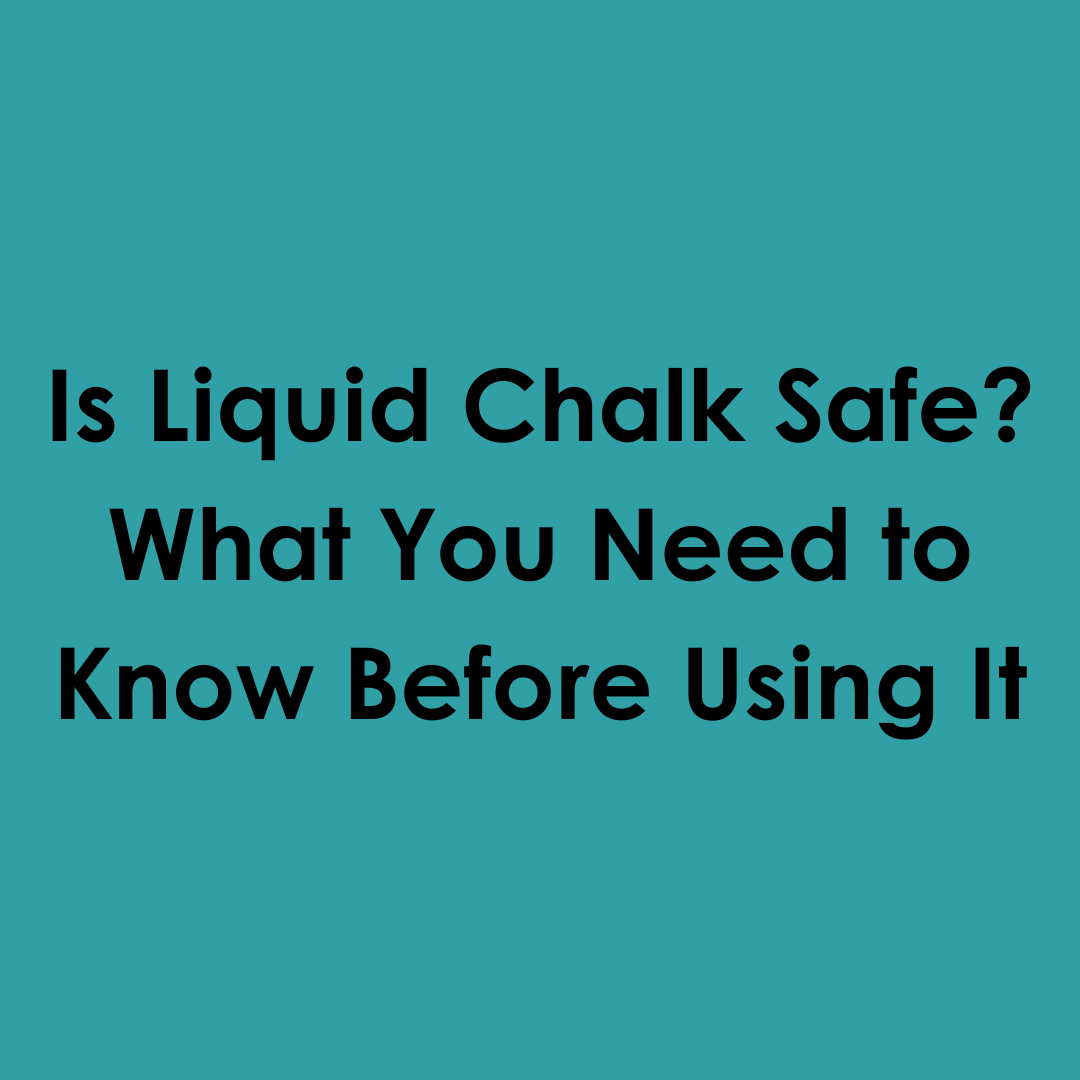Liquid chalk has become a popular tool for athletes across many disciplines, from weightlifting and rock climbing to gymnastics and pole fitness. Offering a cleaner and longer-lasting grip than traditional powdered chalk, it’s easy to see why so many people are making the switch. But, as with any product applied directly to the skin, questions often arise about its safety. In this article, we’ll break down everything you need to know about liquid chalk—what it’s made of, whether it’s safe to use, potential risks, and best practices to ensure safe application.
What Is Liquid Chalk Made Of?
Liquid chalk is typically composed of three main ingredients:
-
Magnesium Carbonate: The primary active ingredient, magnesium carbonate is the same compound used in traditional powdered chalk. It helps absorb moisture, keeping your hands dry during intense physical activity.
-
Alcohol: Most liquid chalks use alcohol (ethanol or isopropyl) as a solvent. This allows the liquid to dry quickly upon application, leaving behind a solid layer of magnesium carbonate on the skin.
-
Binders and Softeners: Some liquid chalks include additives like rosin or other binders to help the chalk stick to the skin more effectively. Others may contain ingredients to reduce skin irritation, making the product gentler.
While these ingredients are generally considered safe for most users, it’s important to understand potential risks associated with each component.
Is Liquid Chalk Safe for Your Skin?
For most people, liquid chalk is completely safe when used as intended. However, individual sensitivities or prolonged exposure can sometimes lead to skin irritation. Here’s what you need to know:
-
Magnesium Carbonate: This ingredient is largely considered safe. In fact, it’s used in many industries beyond fitness, including food processing. Magnesium carbonate itself is not toxic and is generally non-irritating. However, in rare cases, some individuals may develop mild skin reactions, especially with excessive use.
-
Alcohol Content: Alcohol is used in liquid chalk for its fast-drying properties, but it can sometimes dry out the skin, especially with frequent use. This is particularly true for individuals with sensitive skin or existing conditions like eczema. The good news is that alcohol evaporates quickly after application, minimizing long-term exposure.
-
Other Additives: Some liquid chalks include ingredients to improve grip or adhesion, such as rosin (a natural substance derived from pine trees). These additives are usually safe, but certain individuals may experience allergies or irritation. If you have sensitive skin, opt for liquid chalks labeled hypoallergenic or designed for sensitive skin.
Can Liquid Chalk Cause Long-Term Skin Damage?
In general, liquid chalk doesn’t cause long-term damage to the skin, especially when used properly. However, frequent and heavy use without proper care can lead to dryness or cracking, particularly in environments that require a lot of reapplication (e.g., long climbing sessions or intensive CrossFit workouts). The alcohol content can strip the skin of its natural oils, leading to dryness or irritation if not counteracted with proper hydration and moisturization.
To avoid these issues:
-
Moisturize regularly: After your workout, wash your hands to remove any remaining chalk, then apply a good-quality hand moisturizer to restore moisture.
-
Use it sparingly: You don’t need to douse your hands with chalk—just a small amount is often enough to provide a strong grip.
-
Consider skin-friendly formulations: Some liquid chalk products are designed with sensitive skin in mind, including added moisturizers or reduced alcohol content.
What About Inhalation or Ingestion Risks?
One of the main advantages of liquid chalk over powdered chalk is the reduction in airborne dust. With powdered chalk, there is a risk of inhaling fine particles, which can irritate the lungs or worsen pre-existing respiratory conditions like asthma. Liquid chalk eliminates this concern since it doesn’t create dust clouds.
However, ingestion or inhalation of any liquid chalk should be avoided:
-
Keep it away from children: Ensure that kids don’t accidentally ingest liquid chalk or get it in their mouths or eyes.
-
Avoid direct contact with eyes: The alcohol and other ingredients can cause stinging and irritation if they get into your eyes. If this happens, rinse thoroughly with water.
Is Liquid Chalk Safe for Use on Equipment?
Liquid chalk is generally safe to use on most workout equipment. It leaves minimal residue compared to powdered chalk, which can build up on bars, kettlebells, or climbing holds. However, it’s always a good idea to wipe down equipment after use to maintain cleanliness and avoid any buildup over time.
Some gym owners prefer liquid chalk because it reduces mess and requires less cleanup. Additionally, the lack of dust makes it more suitable for indoor environments, particularly in spaces where air quality is a concern, such as climbing gyms or weightlifting facilities.
How to Safely Use Liquid Chalk
To ensure the safe and effective use of liquid chalk, follow these best practices:
-
Apply a Small Amount: A dime-sized amount is usually enough to cover your hands. Rub it evenly across your palms and fingers.
-
Allow It to Dry: Liquid chalk dries quickly, usually within 10-15 seconds. Wait for it to dry completely before starting your workout.
-
Avoid Overuse: Reapplying too frequently can lead to dry skin or irritation. Use only as much as you need for grip.
-
Post-Workout Care: After your workout, wash your hands with soap and water to remove any residue. Apply a moisturizer to prevent dryness.
Who Should Avoid Using Liquid Chalk?
While liquid chalk is safe for most users, certain individuals may need to take extra precautions:
-
People with sensitive skin: If you have a history of skin allergies, eczema, or other conditions, test a small amount of liquid chalk on your skin before extensive use. Opt for products specifically designed for sensitive skin if necessary.
-
Athletes with respiratory issues: Although liquid chalk doesn’t create dust, those with severe asthma or other respiratory conditions should still ensure adequate ventilation when using any kind of chalk in enclosed spaces.
Is Liquid Chalk Safe?
Liquid chalk is generally a safe and effective tool for improving grip during workouts. It offers many advantages over traditional powdered chalk, including less mess, reduced dust, and longer-lasting effects. While most people will have no issues using liquid chalk, it’s important to consider your skin type and follow proper usage guidelines to avoid irritation. For athletes looking to enhance their performance with a reliable grip solution, liquid chalk is a fantastic option with minimal risks when used correctly.
Always test the product on a small area of your skin first if you have concerns, and remember to moisturize regularly to keep your skin healthy and hydrated.
Liquid Chalk Available At Fitness Fox
Fitness Fox offers liquid chalk specifically designed for athletes in weightlifting, rock climbing, gymnastics, and other fitness activities requiring a secure, long-lasting grip. Available in sizes from 50 ml to 200ml, it provides a smooth, mess-free application that dries quickly, leaving a durable layer of magnesium carbonate on the skin. This formula helps reduce sweat, ensuring a solid grip throughout your workout.
Compared to traditional powdered chalk, liquid chalk has the advantage of being much cleaner and more efficient. It doesn’t produce airborne dust, making it ideal for indoor environments like gyms, where maintaining cleanliness is crucial. Additionally, Fitness Fox liquid chalk is skin-friendly, reducing the risk of irritation, which makes it suitable for users with sensitive skin.
The product is portable and easy to use: apply a small amount to your hands, rub evenly, and within seconds, you’re ready to lift or climb. For those who need a reliable grip in intense workouts, Fitness Fox liquid chalk is an excellent choice to boost performance with minimal reapplication needed.




